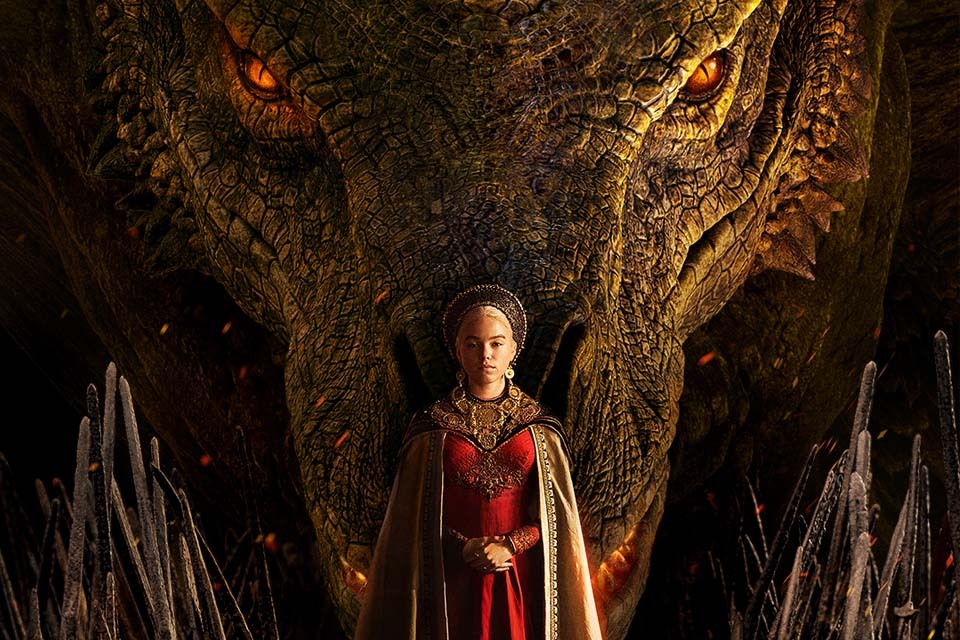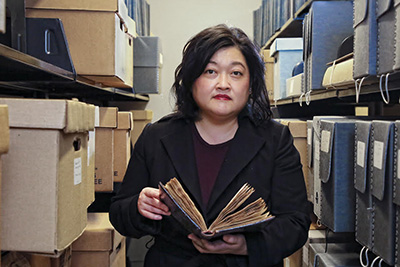How 'House of the Dragon' compares to the medieval era it is inspired by
 Photo/HBO
Photo/HBORhaenyra Targaryen from the "House of Dragons"
"House of the Dragon," the new "Game of Thrones" spinoff from HBO, depicts a world spun of fantasy.
But the noble Targaryan family depicted in the series, who struggle to maintain familial power while tensions rise to a civil war, face challenges similar to those of the medieval royalty who inspired their personas, according to Dorothy Kim, an assistant professor in the English and women’s, gender and sexuality studies.
Kim’s scholarship has been published in numerous respected medieval studies publications, and she shares her knowledge with students in courses like Medieval Play: Drama, LARP, and Video Games, Medieval Travel Writing; and Medieval Women and the Book.
BrandeisNow spoke with Kim to get her thoughts on how the new show weaves in symbolism and themes inspired by medieval Europe, and if she thinks this will be another success for author George R.R. Martin.

Dorothy Kim in the Brandeis Library
Is there a time period that you believe the creators of “House of the Dragon” draw inspiration from?
The original “Game of Thrones” series appeared to be inspired by the time period known as the “Wars of the Roses.” This was the English Royal succession fight in the second half of the 15th century between the Yorks and the Lancasters. Their symbols, the white rose of the Yorks and the red rose of the Lancasters, were combined in the late 15th century in the combined Tudor red and white rose with the marriage of Henry VII (Henry Tudor) and Elizabeth of York.
There is a theory that “House of the Dragon” is loosely inspired by 12th-century England because of the similarities between the plot line and the period of ‘the anarchy.’ King Henry I lost his son, the only heir to the throne, in a boating accident known as the White Ship, in 1120. This created a period of tension over who the next heir to the throne would be, similar to the experience of the character King Viserys Targaryen losing his son and only heir to the throne.
Dragons play a prominent role in this series. Is that consistent with themes from 12th century Europe?
In medieval Europe and England there was an interest in using animals in different symbolism. We can see this in examples such as heraldry flags and armor. For example, the medieval Plantagenet Kings of England used three rampant lions in their heraldry.
They can represent families, aristocratic groups, a certain King’s reign, and various symbols of that sort. This is where we saw the development of creatures such as dragons and unicorns as symbols. The most prominent dragon is the Welsh red dragon which has been a symbol for the Welsh princes and eventually Wales for centuries.
It’s interesting to draw comparisons between the use of dragons in “House of the Dragon” and the new Lord of the Rings series “The Ring of Powers.” The Lord of the Rings creator, J.R.R.Tolkien, created Middle-Earth as this earnest fantasy world with a clear difference between good and evil. The dragon in his series, Smaug, has a specific purpose: an interest in hoarding gold. “House of the Dragon,” however, uses dragons as a symbolic extension of the power of the Targaryen throne.
Who can actually win against dragons? With the Targaryans having access to this kind of power, who would actually try to fight them? Dragons could certainly be interpreted as a metaphor for the nuclear military option. People can’t imagine the use of something with this level of destruction.
Throughout the first few episodes of “House of the Dragon” the Targaryans consider marrying within to keep the throne and power. Is this something that would have occurred in 12th century Europe or simply a shock factor for entertainment?
In 12th-century Europe, incest was a big deal. It was expressly forbidden within the Roman Catholic Church. Historically, it was actually the opposite of the show, as it was a complicated process to assure people did not marry within the family, both blood and spiritual family.
In twelfth-century England, there had to be at least seven degrees of consanguinity away based on canon law. Due to this, they had to make massive charts to track everything, especially for the aristocracy and upper class. You can even see this visualized in this consanguinity chart in a late-12th century manuscript from England.
In fact, there’s a whole conversation about the complexity of King Henry II’s marriage because of this. His wife, Eleanor of Aquitaine, was originally married to Louis VII, King of France. Due to this, her original marriage needed to be annulled by the church on the grounds of consanguinity for her to marry Henry II. So I think the show’s use of incest is a choice they have made.
Overall, the show is creating a medieval fantasy world. The creators can really do whatever they like without worrying about accuracy.
What do you think inspired Martin to use this time period for this series?
The general discussion is that Martin is still writing “Game of Thrones” as a response to J.R.R. Tolkien’s foundational high-fantasy “Lord of the Rings.” Martin apparently wanted to also set a high fantasy series but as a form of “dirty medievalism.” Helen Young’s book “Fantasy and Science Fiction Medievalisms” discusses this contrast in the two series and explains “dirty medievalism.” Apparently, Martin wanted a high-fantasy series that was much more “realistic.” I believe Martin wants to show more political and violent power struggles. I think this is why Martin goes back to the historical power struggles for the crown in medieval England.
Viewers were upset with the finale of “Game of Thrones,” but continue to watch this new series. What makes this such a successful franchise?
I think viewers were originally drawn to “Game of Thrones” because the series surprised viewers with an unexpected twist right away.
In the beginning of the show, the creators tricked us into thinking Lord Stark was going to be the main character because he was set-up as the good hero of season one. When he was killed all his good intentions, along with our expectation that he would be the main hero in a high-fantasy epic, was completely turned upside down.
In retrospect, I think viewers realized that he was politically naive and late to understand how palace power politics were being played. That ending also signaled that no matter how smart you are, how “good” you are, or how hard you try, it still doesn’t matter. No one is ever safe.
You see the series do this again and again, where it sets up certain characters as possibly the “hero/heroine” but then pulls the narrative rug from under the audience and its expectations by killing them off. So, instead of being this hero’s journey we’re introduced to this new type of high-fantasy genre.
Zeynep Tufekci discussed why viewers hated the last season of the HBO series the “Game of Thrones,” as “the storytelling changed from sociological to psychological.” She explained that “at its best, “Game of Thrones” was a beast as rare as a friendly dragon in King’s Landing: it was sociological and institutional storytelling in a medium dominated by the psychological and the individual. This structural storytelling era of the show lasted through the seasons when it was based on the novels by George R. R. Martin, who seemed to specialize in having characters evolve in response to the broader institutional settings, incentives and norms that surround them.”
I agree with her assessment. I think people were upset at the end of “Game of Thrones” because the creators flipped the switch. Unlike the rest of the show, it ended up as a psychological hero’s adventure story. You basically were watching a high-fantasy medievalism version of The Wire and then you got a high-fantasy medieval Marvel cinematic universe superhero story.
For “House of the Dragon,” I think viewers are looking for what worked in the first seasons of “Game of Thrones.” I think we’re trying to see if they’ll mess it up again.
Categories: General, Humanities and Social Sciences, Research





